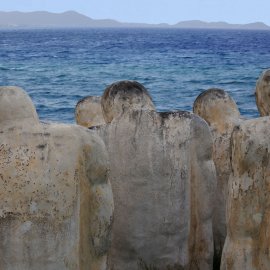The Slave Route
-
English
-
ListenPause
[intro music]
Welcome to World Ocean Radio…
I’m Peter Neill, Director of the World Ocean Observatory.
Slavery remains a source of basic injustice worldwide. It is an ocean story, a demonstration of exchange, humans as a commodity in international maritime trade. The Trans-Atlantic story demonstrates a “triangular” system of connection across the seas, from Africa to the Americas to raise crops such as sugar and tobacco traded to England and Europe from which manufactured goods were traded back to Africa in a cycle of finance based on enslaved labor that fostered death, brutality, and the shaping of values that have passed down as the foundation for political strife, racial discrimination, continuing contemporary inequality and injustice. Sadly, it is a first manifestation of what we today call globalization.
But the trans-Atlantic story is but one of three, the others evident in the Indian Ocean and the Middle East and Asia. The United Nations Educational, Scientific and Cultural Organization (UNESCO) has documented these histories in a project called “The Slave Route,” an inventory of “memory,” of places and events “to assist in providing a better understanding of the causes, forms of operation, issues and consequences of slavery in the world, to present global transformations and cultural interactions that have resulted from this history, and to contributed to a culture of peace by promoting reflection on cultural pluralism, intercultural dialogue, and the construction of new identities and citizenships.” Sites memorializing this history have been designated in the United States, United Kingdom, France, Cuba, Guadeloupe, Nigeria, Turks and Caicos, Barbados, and Jamaica, and Peru. There are many more, and one hopes that today’s growing awareness and response to endemic racism and its history will provide impetus for many more.
We often consider slavery in the context of colonization, and indeed “colonizers” – primarily American, English, Dutch, and Portuguese – were complicit, procuring human “goods” by purchase, dislocation by local calamity, and internal rebellion or tribal conflict. There was a market, internal supply for external demand, all of it tragic, rationalized by circumstance, immoral, and deadly. But it is clear that labor for the exploitation of resources available through colonial outposts connected by trans-ocean connection was a transformational economic enterprise with far-reaching social consequence that continues to this day. That must be understood.
There are, of course, modern examples of slavery: specifically, in illegal labor migration and human rights abuse and trafficking, primarily of women and children in the context of the trade of drugs and sex workers. Consider the definition of such conduct: “the recruitment, transportation, transfer, harboring, and receipt of persons, by means of threat or use of force or other forms of coercion, of abduction, of fraud, or deception or benefits to achieve the consent of a person having control over another person, for the purpose of exploitation.” There are sordid ,overt examples: a shipping container discovered with impoverished refugees to be
smuggled into a country illegally without security or standing beyond the power of their recruiters and their masters. They can be revealed or traded or disappeared as chattel at any time at the convenience of their owners.But there are other, more covert, ways to enslave: to provide illegal documents, to under-pay for hard labor rendered, to delimit living conditions and finances, to hold such power as leverage against escape, self-improvement, advancement, and freedom. The threat of deportation and return to tyrannical origins, sweat shops, menial and transient work opportunities, wage scales untenable for basic survival, educational and employment bias, segregated communities of impoverished and working poor, visa and citizenship policies, voter discrimination, racial profiling by police, and the innumerable incidents of subtle, and not so subtle prejudice felt every day, mostly by people of color, the daughters and sons of the enslaved at the hands of the sons and daughters of the slavers. Inherent in this is more than an itinerary of historical place and event, but also a passage of historical responsibility, accountability, understanding, and reparation.
We will drown in the turbulent sea of injustice. No one really survives without intervention by virtue of personal or collective will to do so. Injustice knows no limits unless it is resolved by redress and change. Immorality can only be combated by the affirmation of morality. A context of amorality or inaction, will not fease.
It is an ocean story, and we are adrift.
We will discuss these issues and more in future editions of World Ocean Radio.
[outro music]
In this episode of World Ocean Radio, part two of the five-part Slavery: Heritage and Identity series, we discuss trans-Atlantic slavery in the context of the UNESCO Slave Route Project: Resistance, Liberty, Heritage that was established to break the silence and liberate the history surrounding slavery and the slave trade.
About World Ocean Radio
A weekly 5-minute podcast covering a broad spectrum of ocean issues from science and education to advocacy and exemplary projects. World Ocean Radio, a project of the World Ocean Observatory is available for syndicated use at no cost by college and community radio stations worldwide. Contact [email protected] if you are interested in becoming an affiliate or know of a radio station that should be broadcasting these episodes each week.
Image
The Anse Cafard Slave Memorial sits high on a hill in southwest Martinique, facing Diamond Beach and the Caribbean Sea. The memorial of 20 white stone effigies was completed in 1988, the 150th anniversary of slave emancipation in the French West Indies.
Learn More
UNESCO Slave Route: Resistance, Liberty, Heritage
- Login to post comments



